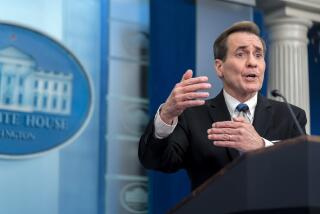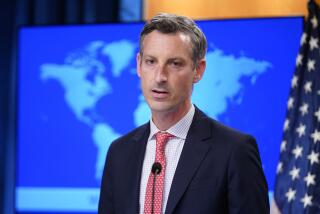Priorities List Is Reagan’s Aim in Gorbachev Meeting
- Share via
WASHINGTON — At the Geneva summit next month, President Reagan will try to hammer out an agreement with Soviet leader Mikhail S. Gorbachev establishing a list of specific priorities that “can move negotiations ahead a little more rapidly toward practical solutions” on arms control, as well as other areas of U.S.-Soviet relations, according to an Administration official.
In addition to strategic arms talks, “we are testing (the Soviets) in a wide range of areas where we’d like to see progress” at the November summit and afterward, he added. He said that he would “not prejudge precisely what form” such an agreement might take but that it would contain specific commitments, rather than be a vague statement of principles for future conduct.
The official’s remarks, together with those of other Administration aides during a White House briefing Thursday, were taken as one more sign that Reagan has set his summit sights on an arms control statement that would break the present negotiating impasse and open the way for a future agreement, as well as provide a more stable basis for U.S.-Soviet relations in coming years.
In Moscow, another American official said Friday: “They can’t negotiate arms control at Geneva. There’s no way to do that in two days” at the summit. However, he added, “Maybe they can give guidance for future work--guidance to negotiators on a detailed subject.”
A model for such an approach, other officials say, could be the joint U.S.-Soviet statement of May 20, 1971, that broke the strategic arms deadlock and led a year later to the first strategic arms accords. It established the principle that agreement on both defensive and offensive weapons must be reached simultaneously.
The 1971 statement said that the two nations would “concentrate this year” on reaching an agreement to limit defensive anti-ballistic missiles “together with” an agreement to limit some offensive intercontinental weapons. The Anti-Ballistic Missile Treaty and the first Strategic Arms Limitation Treaty were signed during the summit meeting of former President Richard M. Nixon and then Soviet President Leonid I. Brezhnev in Moscow on May 26, 1972.
The Administration continues to insist that it will not negotiate over its research on anti-missile weapons based on laser beams or other directed energy technology under the Strategic Defense Initiative, or “Star Wars,” program. The Soviets, in turn, insist that without some constraints on “Star Wars,” they will not make the deep 50% cuts in nuclear arsenals that they recently proposed.
View From Moscow
Nonetheless, in the view of the American official in Moscow, the Soviet weapons reduction proposal increases the possibility of an arms control accord, despite U.S. disagreement with some parts of the plan. The official, who asked that he not be identified, made his appraisal after Soviet Foreign Minister Eduard A. Shevardnadze met Friday with Arthur A. Hartman, the U.S. ambassador to Moscow, on preparations for the summit.
“The elements are all there on the table to really have a serious discussion and negotiation,” the official said. “But it (an agreement) is not going to happen in the 30 days between now and (the summit meeting in) Geneva. Our positions are still far apart, but we do like the fact that it (the Soviet proposal) deals realistically with offensive weapons and warheads and suggests a limit on land-based missiles.”
Even so, U.S. officials continue to declare the Strategic Defense Initiative off-limits. One Administration expert on Soviet affairs said at the White House briefing that if the United States “conceded that SDI is a bargaining chip” for trading against Soviet offensive weapons, political support for the “Star Wars” program would dwindle in Congress and the nation. The Soviets would thereby succeed in hobbling SDI without giving any concession in return, he said.
In the same vein, a senior official defended the Administration’s efforts to reinterpret the ABM treaty more broadly in recent weeks, as well as public statements on the issue by national security adviser Robert C. McFarlane.
The nub of the ABM treaty issue is that former Administrations--including Reagan’s, until now--took the position that the pact permitted only research on missile defenses, whether based on conventional rocketry or on new directed-energy technology. Recently, however, Administration officials have declared that, after reviewing the treaty, they have decided that it in fact permits development and testing, as well as research, on missile defenses using the new technology.
Original Interpretation
More recently, the Administration has said that it will continue the SDI program within the narrow restrictions of the original interpretation, although it may end this self-imposed limitation in the future.
On Friday, the senior official said this latest position was accepted “unanimously by all Cabinet officials” before McFarlane first mentioned the reinterpretation decision two weeks ago. The official’s remarks were a further attempt to discredit reports that Secretary of State George P. Shultz opposed the revised interpretation and threatened to quit unless it was changed.
In a continuing effort to quash reports that the Administration is in disarray over the summit and the Soviet arms reduction proposal, U.S. officials portrayed Administration planning as careful and logical, based on objective analyses of Gorbachev’s actions so far and aims for the future. “In our judgment,” one Kremlinologist said, “for military, economic and other reasons, the President goes to Geneva with the strongest hand of any President since (Dwight D.) Eisenhower in 1955.”
He based this assessment on the view that, while Gorbachev has quickly consolidated his power, the Kremlin leader’s first priority is improving the Soviet economy. At the same time, he wants increased investment in industry and for output of consumer goods and seeks to end the Soviet lag in technology.
The result, in foreign policy terms, is that Gorbachev “needs a breather. He wants and needs help from the West to correct his economic problems,” the official said.
Speaking of Gorbachev and Reagan, the American source in Moscow said: “It’s important that they get together and talk once in a while, take stock of the relationship and see if they can give any guidance to their negotiators on arms control issues.”
In addition, he said, there is a “very good chance” that an across-the-board agreement on educational, cultural and scientific exchanges will be concluded by the time the summit conference begins. If so, it could be signed by Reagan and Gorbachev in Geneva, he said.
‘Atmospheric Detente’
Thus, the Soviets are seeking “atmospheric detente” that would facilitate trade and technology exchanges while putting public pressure on the United States to reduce defense efforts, the official at the White House briefing said. Another aim is an arms control situation that would stop U.S. military programs from eroding Soviet arsenals and that would “avoid a massive new spending program” to keep up with the United States, he said.
However, there has been no change in Soviet behavior that would suggest that the Soviets are willing to make significant concessions at the negotiating table to achieve their goals. “On the basis of what Gorbachev has been saying and doing, he’s not ready” to make major changes of directions in Soviet policies at home or abroad, another Administration Kremlinologist said.
Nevertheless, publicly, Soviet officials have been billing the Reagan-Gorbachev meeting as an opportunity to achieve a major breakthrough in limiting nuclear weapons in space and on Earth.
Gorbachev himself said in a recent interview that it would be wrong to go to Geneva just to smile for television cameras. “All the people of the world are waiting for concrete, positive steps from the leaders of the superpowers,” the Kremlin leader said.
U.S. officials in Washington and elsewhere have been trying to lower expectations for the Geneva conference. At one point, they even argued against using the word “summit,” on the ground that it might raise too much hope.
“There are no miracles made at a summit,” the source in Moscow said. “People should not expect miracles.”
Robert C. Toth reported from Washington and William J. Eaton from Moscow.
More to Read
Sign up for Essential California
The most important California stories and recommendations in your inbox every morning.
You may occasionally receive promotional content from the Los Angeles Times.









